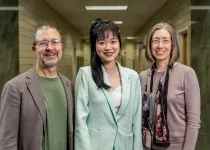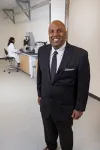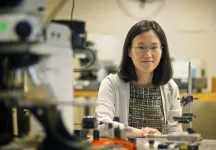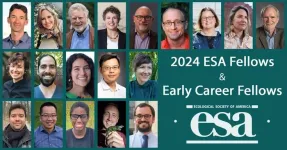(Press-News.org) MADISON — In an effort to improve delivery of costly medical treatments, a team of researchers in electrical engineering at the University of Wisconsin–Madison has developed a stimulating method that could make the human body more receptive to certain gene therapies.
The researchers exposed liver cells to short electric pulses — and those gentle zaps caused the liver cells to take in more than 40 times the amount of gene therapy material compared to cells that were not exposed to pulsed electric fields. The method could help reduce the dosage needed for these treatments, making them much safer and more affordable. The research appears April 30 in the journal PLOS ONE.
Gene therapy is a promising medical technology: By replacing, altering or introducing new genetic material into a patient’s cells, doctors may be able to cure or compensate for genetic diseases, including cystic fibrosis, sickle-cell disease, hemophilia and diabetes.
One of the bottlenecks in gene therapy, however, is getting the right dose of genetic material into the target cells. The UW–Madison research suggests that applying a moderate electric field, which left no lasting damage to the cells that received it, could help in creating more effective therapies.
The project began almost a decade ago with Hans Sollinger, a world-renowned transplant surgeon at UW–Madison. He had developed a gene therapy treatment for Type 1 diabetes, an autoimmune disease that attacks the pancreas, the organ that produces insulin.
Sollinger’s treatment strategy delivered the genetic code for insulin production into liver cells using an adreno-associated virus that assists in transporting the therapeutic genes across the cells’ membrane. This DNA can then take up residence in liver cells, producing insulin without being attacked by the immune system in the pancreas.
While Sollinger had a proof of concept that the therapy worked, he believed the future of the treatment hinged on delivery. He turned to Susan Hagness and John Booske, both UW–Madison professors of electrical and computer engineering who have experience treating human cells with electrical pulses.
“What we started talking about was local, targeted delivery and whether there was a way of getting the treatment DNA directly into the liver without passing it through the entire body and triggering the immune system,” says Hagness. “And whether we could use electric pulses in order to make this delivery process more efficient and dramatically reduce the dose needed.”
Researchers have previously found that exposing cells to electric fields can often increase the ability of molecules to move through the cell membrane into the interior of a cell. So, in this latest study, PhD student Yizhou Yao sought to determine whether the technique would increase the penetration of virus particles into liver cells.
Using human hepatoma cells, a model system for studying the liver, Yao exposed batches of the cells to various concentrations of the gene therapy virus particles containing a fluorescent green protein. She used a pair of electrodes to deliver an 80-millisecond electric pulse to some samples, then incubated all the cells for 12 hours.
When she examined the results 48 hours later under a fluorescence microscope, Yao found that only a small percentage of the cells that had not received the electrical pulses glowed green. In stark contrast, those cells that had received a zap accumulated about 40 times the amount of the fluorescent green proteins delivered by the virus.
While results provided compelling evidence that the pulses helped facilitate the virus’s penetration of the cell walls, Booske says the team has yet to discover exactly how the process works at the molecular level.
“There’s enough known about electric pulsing that I think we could confidently state that it is opening nanopores through the cell membrane,” he says. “But then Yao got this remarkable result, and it dawned on us that virus particles are in general bigger and more complex than bare molecular particles and they already have their own way of getting inside cells. So, we don't really know if it's the pores opening that has anything to do with it directly or indirectly.”
Sollinger passed away in May 2023, but the team says his legacy will live on through the ongoing research on this project and the work of other groups. The electrical engineering researchers are pursuing next steps with external funding and are optimistic that ultimately the technique will translate into clinical trials.
Yao, who will graduate in 2024, says she knew the study would be transdisciplinary, but didn’t realize just how far it would go.
“I am an electrical engineer by training, and I don’t have a biology background,” she says. “Before this, the last time I used a microscope was in high school. It was quite a steep learning curve, learning to culture cells and carry out biology protocols. But I really enjoyed this project and liked its ultimate goal, which is to make the world a better place.”
Other authors include Robert W. Holdcraft of the Cincinnati Children’s Hospital Medical Center.
END
An electrifying discovery may help doctors deliver more effective gene therapies
2024-04-30
ELSE PRESS RELEASES FROM THIS DATE:
Lurie Children’s Hospital first-in-pediatrics to use technology that lights up lung cancer during surgery
2024-04-30
Ann & Robert H. Lurie Children’s Hospital of Chicago is pleased to announce the first pediatric use of the novel fluorescent agent CYTALUX during surgery to remove lung metastases. The drug allows surgeons to better visualize cancer in the lung, as well as potentially detect additional cancerous nodules missed by preoperative imaging. This drug is FDA-approved in adult patients, but Lurie Children’s is the first-in-pediatrics to have an Investigational New Drug application with the FDA to study ...
$3.6 million to advance nuclear energy awarded to U-M
2024-04-30
Four U-M projects funded by the Department of Energy's Nuclear Energy University Partnerships program aim to make nuclear energy safer and more equitable.
The projects are designed to improve the monitoring of nuclear reactors during operation; explore the safety of an advanced modular reactor design; develop a framework for ethical, consent-based siting of nuclear facilities; and upgrade a facility for modeling radiation damage to reactor components.
Real-time radiation effects on optics
How well could optical sensors monitor future advanced nuclear reactors? Funded with $1 million, Igor Jovanovic, a professor of nuclear ...
Two UT Arlington faculty honored for outstanding research
2024-04-30
The University of Texas at Arlington is honoring two faculty for their outstanding contributions to research.
Yuze (Alice) Sun, associate professor of electrical engineering, and Venu Varanasi, associate professor in the Bone Muscle Research Center, are the 2024 recipients of the University Award for Outstanding Research Achievement or Creative Accomplishment. This award recognizes faculty members for achieving significant research or creative accomplishments during the past three years.
“Alice and Venu are truly bright stars on the faculty at UT Arlington,” ...
UT Arlington student links worm behavior to brain disease
2024-04-30
As an undergraduate student in The University of Texas at Arlington’s Honors College, Hannah Selvarathinam knew she wanted to conduct research. Near the end of her first year at UTA, the Keller native reached out to the lab of biology Assistant Professor Piya Ghose.
“Hannah has been a very impressive scholar from Day 1,” Ghose said. “She had the foresight to reach out for research opportunities very early on.”
Ghose brought Selvarathinam in to work on one of the lab’s core projects ...
Uncovering the secret of long-lived stem cells
2024-04-30
Nothing lives forever, but compared to other cells in the body, hematopoietic stem cells (HSCs) are remarkably long-lived. HSCs are blood-forming cells – they give rise to rapidly dividing progenitor cells, which in turn generate hundreds of billions of cells to fulfill the daily demand of oxygen-delivering red blood cells, disease-fighting white blood cells and clot-forming platelets.
HSCs typically remain dormant within the bone marrow, yet they possess the ability to activate and replenish blood cells continuously, maintaining a relatively youthful profile throughout the life of an organism. What is the secret of ...
The question for online educational platforms: offer courses following a schedule or release them on demand?
2024-04-30
Researchers from Carnegie Mellon University and University of Pennsylvania published a new Journal of Marketing study that examines online educational platforms and the question of whether they should release content through a scheduled format that resembles a traditional university course or use an on-demand release strategy.
The study, forthcoming in Journal of Marketing, is titled “More Likely to Pay but Less Engaged: The Effects of Switching Online Courses from Scheduled to On-Demand Release on User Behavior” and ...
Study: racial bias is no 'false alarm' in policing
2024-04-30
Black drivers are more frequently searched during traffic stops without finding contraband than white drivers, according to a University of Michigan study.
Institute for Social Research scientists Maggie Meyer and Richard Gonzalez analyzed data from 98 million traffic stops, and showed that innocent Black drivers were likely to be searched about 3.4 to 4.5 percent of the time while innocent white drivers were likely to be searched about 1.9 to 2.7 percent of the time. Their results are published in the Journal of Quantitative Criminology.
"We show that there's ...
Ecological Society of America announces 2024 Fellows
2024-04-30
The Ecological Society of America is pleased to announce its 2024 Fellows. The Society’s fellowship program recognizes the many ways in which its members contribute to ecological research, communication, education, management and policy. This year, the ESA Governing Board has confirmed nine new Fellows and ten new Early Career Fellows.
Fellows are members who have made outstanding contributions to a wide range of fields served by ESA, including, but not restricted to, those that advance or apply ecological knowledge in academics, ...
Mass General Brigham researchers identify potential drivers of chronic allergic inflammation
2024-04-30
Currently, most therapies for allergic diseases require lifelong treatment. Allergic reactions, characterized by ongoing (type 2) inflammation in response to chronic antigen exposure, underlie many chronic diseases in humans, including asthma, atopic dermatitis, ulcerative colitis and more. T helper 2 (Th2) cells play an important role in the body's immune response, particularly in allergic reactions. Despite their central role, the sustained activity of Th2 cells during allergic reactions, even in the face of constant antigen exposure, has long puzzled researchers.
A research team that included authors from Mass General Brigham, including ...
Scientists solve chemical mystery at the interface of biology and technology
2024-04-30
Link to release:
https://www.washington.edu/news/2024/04/30/oects/
Researchers who want to bridge the divide between biology and technology spend a lot of time thinking about translating between the two different “languages” of those realms.
“Our digital technology operates through a series of electronic on-off switches that control the flow of current and voltage,” said Rajiv Giridharagopal, a research scientist at the University of Washington. “But our bodies operate on chemistry. In our brains, neurons ...





